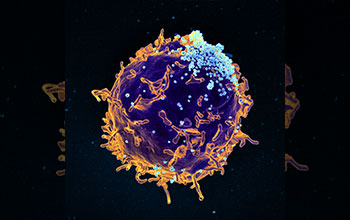Multimedia Gallery
Viruses impaired if their targets have diverse genes
This scanning electron microscope image shows newly formed Friend virus particles (upper right in light blue) budding from an infected white blood cell known as a T-lympocyte. The virus was used in a University of Utah study that suggests how increasing genetic diversity in livestock and in captive-bred endangered species may help protect them from infection.
In the past, research on plants and insects has shown that a virus replicates faster and becomes more virulent when it rapidly adapts to the "host" it infects because the host species has low genetic diversity. However, such findings have not been shown in vertebrate species, although it has been theoretically predicted for over two decades, until now.
The University of Utah study is "the first time that anyone has shown that genetic variation within a single vertebrate animal species strongly inhibits replication of a virus and the severity of disease it causes," says Jason Kubinak, a postdoctoral fellow in biology at the University of Utah and first author of the study.
In their study, the researchers found when a viral infection spread through five genetically identical mice in a row, the virus replicated faster and became more virulent or severe. But when the infection spread one-by-one through five genetically diverse mice, the virus had trouble adapting and became less virulent.
"This study showed a surprising rapid and large effect of genetic diversity in mice that dramatically reduced the replication of virus infecting the mice and the severity of disease caused by the virus," says biology professor Wayne Potts, the senior author of the study.
With diseases like hoof and mouth already a big concern for livestock, results of this study suggest that "instead of using a limited set of breeds, maybe using multibreed herds might limit the ability of a pathogen in that setting to become highly virulent," Kubinak says. "This also may reduce resistance to antibiotics that develops when livestock are given the drugs to prevent infection and promote growth."
The research finding may also be applied to captive-bred endangered species that are reintroduced into the wild, which have a high rate of failure--near 80 percent. Wayne Potts, a biology professor and senior author of the study, says there are a number of hypotheses as to why but one of them is that low genetic diversity, created by collapsing population size that made them endangered, may make them an easier target for parasites and pathogens. "This suggests that the captive-breeding programs and reintroduction programs should maximize genetic diversity. Once we identify which host genes are important--and we assume it will be immune system genes--captive-breeding programs could maximize diversity of these critical immune system genes," says Potts.
This research was supported in part by a grant from the National Science Foundation (grant DEB 09-10052).
To learn more, see the University of Utah news story Viruses impaired if their targets have diverse genes. (Date image taken: 2012; date originally posted to NSF Multimedia Gallery: Oct. 1, 2015)
Credit: Elizabeth Fischer and Austin Athman, NIAID, NIH
Images and other media in the National Science Foundation Multimedia Gallery are available for use in print and electronic material by NSF employees, members of the media, university staff, teachers and the general public. All media in the gallery are intended for personal, educational and nonprofit/non-commercial use only.
Images credited to the National Science Foundation, a federal agency, are in the public domain. The images were created by employees of the United States Government as part of their official duties or prepared by contractors as "works for hire" for NSF. You may freely use NSF-credited images and, at your discretion, credit NSF with a "Courtesy: National Science Foundation" notation.
Additional information about general usage can be found in Conditions.
Also Available:
Download the high-resolution JPG version of the image. (14.8 MB)
Use your mouse to right-click (Mac users may need to Ctrl-click) the link above and choose the option that will save the file or target to your computer.

